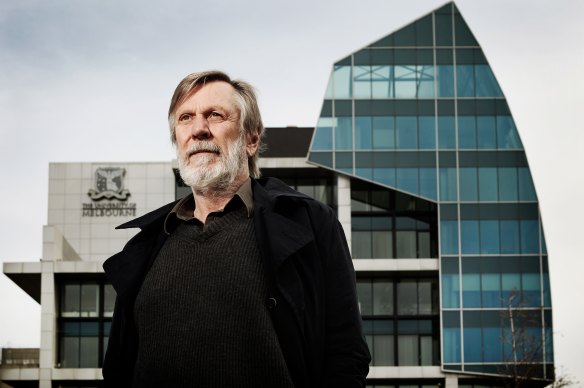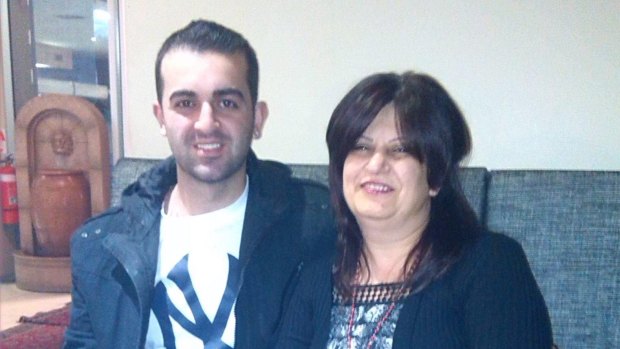As a draft dodger who liked to get in the face of police at anti-war rallies, public health expert Professor Nick Crofts has undergone not so much a transformation as a realisation.
“I was a left wing hippy who thought police were the agents of fascist governments,” he says.
Nick Crofts at The Nossal Institute for Global Health in Carlton.Credit:Fairfax
Now, having worked and studied in Australia, Europe, Asia, Canada and the US, he is convinced that, unless law enforcement and health professionals work together, our hospitals will remain clogged, our jails full and those with mental health issues stuffed into the court system because it is easier to punish than help.
On the day we met in the colourful end of St Kilda he had seen police taser a suspect outside his door. It did not surprise him.
The executive director of the Global Law Enforcement and Public Health Association, Crofts began his journey as a doctor at the Collingwood Community Health Centre where he first thought police were part of the problem not the solution.
One of his patients was a young man with a mental health condition who had barricaded himself in a flat. “Two young cops said, ‘Stand aside, Doc,’ and opened the door not knowing what would be on the other side.”
There are hard-nosed police, he says, who make bad situations worse by arresting vulnerable people who should never see the inside of a cell. But cops are usually first on the scene and need to partner with health experts if we are to make any difference.
Crofts saw this first-hand when neighbours called authorities after seeing an elderly woman lying motionless on her couch for days.
“She had scurvy and needed to go to hospital,” he says. While she was recovering the doctor and local constable, Lucio Rovis (later a respected homicide detective), helped fix her house.
It showed Crofts that the answer to many problems can’t be found in law or medical books.
In the early 1980s as an epidemiologist, he worked at the Fairfield Infectious Diseases Hospital at the beginning of the HIV epidemic, concentrating on the spread among illicit drug users through infected needles.
In some areas of the world tainted needles spread more of the infection than male-to-male sex, yet the drug community was stigmatised with one Asian senior policeman telling Crofts, “AIDS and drugs will solve each other.”
“He saw it as social cleansing,” says Crofts.
In Australia, we live in a time when more police, tougher sentencing and new jails are seen as the answer, which only means people aren’t asking the right questions.
“We have to have the courage to say what we are doing is not working,” says Crofts.
“The level of incarceration is going through the roof and no one seems shocked.”
We are investing in a broken system – and those who are making political mileage from the “get tough on crime” message bloody well know it. It is trading the practical for the popular, leaving the problem for later generations.
Bad criminals belong in jail, to punish them and protect us. But locking up those on the fringes only guarantees they will return to the streets to offend again.
Crofts says between 40 and 70 per cent of prisoners have an acquired brain injury.
“We use jail to mop up our failures. It saves us from dealing with the real problems that require funding,” he says.
While the sick need to be treated and the dangerous should be punished, what happens when the sick become dangerous? It is so much easier to send the cops to lock them up than deal with the underlying conditions.
And there are more votes in opening a prison than a psychiatric clinic.
Talk to street police, and they will tell you they spend more time dealing with social welfare problems than serious crime. They work with health professionals but say too often the gears fail to mesh.
Talk to senior police, and they don’t want to be the lead agency. Chief Commissioner Shane Patton says, “We can’t keep doing everything. Some policing roles have nothing to do with policing at all.”
There are more votes in opening a prison than a psychiatric clinic.
Crofts says you first have to persuade those on the front line to change. “Some in public health see police as the enemy and cops say, ‘What would you know about policing?’.”
He says an American senior officer told him one third of cops believe in change, one third are open to change and one third will never change.
The recent Mental Health Royal Commission recommended, when possible, health professionals, rather than police, lead the response in “critical mental health crises”.
It wants mental health calls to triple zero diverted to Ambulance Victoria rather than police. Except the ambulance service is struggling with the present workload. Cops are sent not because they are the best option but because they are the only option.
Every 12 minutes police respond to a mental health call. Every 40 minutes they take someone to hospital to be assessed under the Mental Health Act.
No matter how well they are trained, police are not mental health experts, and it costs thousands of patrol hours.
By the time a mental health issue has become a crisis it is often too late. It requires a response in minutes, but those first on the scene have to deal with people who have often been failed by the system for years.
Take the tragic case of Gabriel Messo. His family repeatedly tried to get him mental health treatment, then in July 2020 he was taken by police to hospital, released and then bailed. The next day he lured his mother, Lilla, to a park and stabbed her repeatedly until he was shot dead by a policeman who’d graduated only two months earlier.
Gabriel Messo and his mother Lilla. Credit:Facebook
This is not their problem, it is our problem. When you need an ambulance it may be caught dealing with someone threatening to take their own life, and when you need a doctor in casualty they may be dealing with a drug affected patient. And when you need police they may be caught up taking the drug affected or mentally ill to hospital to be assessed.
Yet, there are other ways – if we are prepared to accept that what we are doing won’t work in the long term.
As former Victoria Police chief commissioner Ken Lay once said, “We can’t arrest our way out of our problems.”
In most (but not all cases) there are key intervention points where treatment would avoid the flashpoint and would prove cheaper, smarter and more humane.
We have a problem with gangs – and we are not the only ones.
In 2005-06, of the 185 people charged with homicide in Scotland, 25 percent were under 21 – 60 per cent 30 or younger and 60 per cent were drunk.
The most dangerous area was Glasgow, where police were given tough new knife laws. Things just got worse.
Enter Karyn McClusky, a forensic psychologist who headed the Strathclyde Police intelligence section and joined the violence reduction unit.
It identified more than 150 gangs with 3500 members – most were from poor areas, where job opportunities were limited and had suffered family violence.
Crofts says McClusky showed vision of a stabbing committed by a teenager running down the street, then asked, “Who is this kid?”
A profile showed he lived in a violent area and there were multiple times when authorities should have intervened – when he ducked school, started shoplifting and committing further offences.
Police started to view gang violence as a disease that you catch when you are young through geographic hot-spots, family violence, lack of jobs and lack of positive male role models.
Authorities set up a 24-hour hotline to offer advice on health, education and employment. The system was introduced throughout Scotland and homicides dropped by 50 percent.
Scottish police used to be all about enforcement, now it is intervention first. Recently, all Scottish operational police were equipped with a drug overdose nasal spray, showing how police and health overlap.
Crofts talks of a Melbourne teenager of Vietnamese descent who left school at 15, “functionally illiterate” and a long-term victim of racism.
With no job opportunities, he sold heroin for a gang. “He could make $5000 a week and have to go to a country retreat occasionally [jail] where he was given three meals a day and there was a gym. Why wouldn’t you?”
Crofts worked in the Netherlands for years and saw how every year police identified the top 600 people (not necessarily their worst criminals) that took up most of their time.
They would throw resources such as jobs, shelter, clothing, mental health and drug treatment at them to try get them off the books. Now they are closing prisons rather than building them.
Our news is filled with horrible crimes and terrible crooks, but the average citizen is more likely to be damaged by a local offender who commits burglaries and street violence.
Every district has them – habitual low-level crooks that the criminal justice system can’t control and the health system apparently can’t help.
Crofts says there is a better way. If we are only prepared to look. He says we need a police/public health joint approach to get the best ideas in the world and apply them on the street.
After all, they (and we) are on the same side.
The best of Good Weekend delivered to your inbox every Saturday morning. Sign up here.
Most Viewed in National
From our partners
Source: Read Full Article

